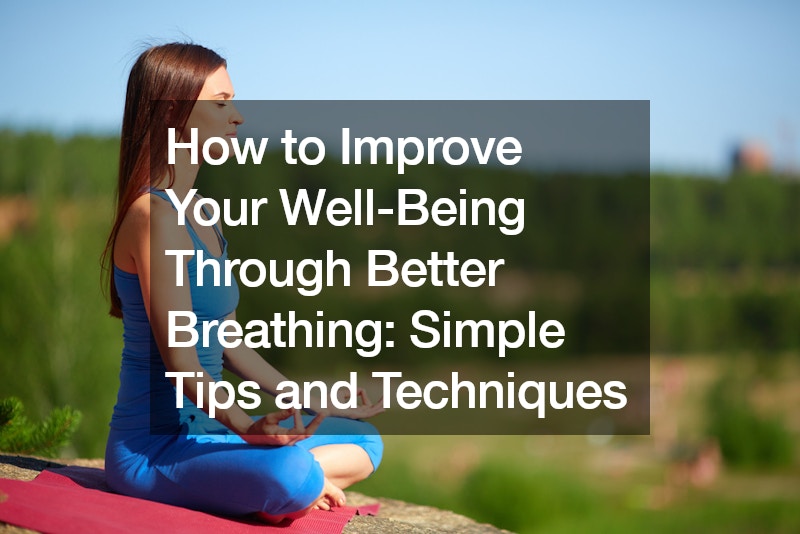In our fast-paced lives, it’s easy to overlook the importance of something as fundamental as breathing. Yet, the way we breathe has a profound impact on our physical and mental well-being. By learning to breathe more efficiently, we can enhance our vitality, reduce stress, and improve our overall quality of life. In this article, we’ll explore some simple tips and techniques for better breathing that anyone can incorporate into their daily routine.
Focus on Your Breathing Pattern: The first step to better breathing is to become aware of your breathing pattern. Are you primarily breathing from your chest or your abdomen? Chest breathing, which involves shallow breaths that mainly use the muscles in the chest and neck, can lead to reduced oxygen intake and increased stress levels.
On the other hand, abdominal breathing, also known as belly breathing, engages the diaphragm and allows for deeper, more efficient breaths. To practice abdominal breathing, place one hand on your chest and the other on your abdomen, then take slow, deep breaths, focusing on expanding your belly with each inhale.
Slow Down Your Breathing Rate: The frequency of our breaths also plays a crucial role in our well-being. While the average person takes 12 to 16 breaths per minute, slowing down the breathing rate to around 6 breaths per minute can have significant benefits. This optimal breathing rate enhances lung ventilation, improves oxygen saturation levels in the bloodstream, and promotes relaxation. You can practice slowing down your breathing by taking long, deep breaths and consciously extending the duration of each exhale.
Exhale Longer Than You Inhale: Another key aspect of effective breathing is to exhale longer than you inhale. This technique stimulates the vagus nerve, which activates the body’s relaxation response and helps reduce stress and anxiety. To practice this, try counting the length of your inhale, then exhale for twice as long. For example, if you inhale for a count of four, exhale for a count of eight.
Pay Attention to Your Posture: Believe it or not, your posture can impact your breathing. Sitting or standing with slouched shoulders and a rounded back can restrict the movement of your diaphragm and reduce lung capacity. To optimize your breathing, sit or stand up straight with your shoulders relaxed and your spine aligned. This allows for better chest expansion and airflow, resulting in improved respiratory function.
Choose Nose Breathing Over Mouth Breathing: Breathing through your nose is preferable to breathing through your mouth for several reasons. The nasal passages are lined with specialized respiratory cells that filter and humidify the air, while the mouth is lined with digestive tissues. Nose breathing helps prevent the inhalation of harmful particles and allergens, and it also promotes better oxygen absorption in the lungs. During physical activities or yoga class, focus on breathing through your nose whenever possible to maximize the benefits.
Incorporating Breathing Techniques into Daily Activities: Integrating breathing exercises into your daily routine can significantly enhance your overall well-being. Whether you’re walking, working, or driving, taking a few moments to practice mindful breathing can help reduce stress, increase focus, and promote relaxation. Simple techniques like deep belly breathing or mindful breathing can be easily incorporated into your day without disrupting your schedule.
Combining Breathing Exercises with Yoga: Yoga and breathing techniques are deeply intertwined, with breath work being a fundamental aspect of yoga practice. Attending a yoga class offers an opportunity to explore various breathing techniques in a supportive environment guided by an experienced instructor. In a yoga class, you’ll learn how to synchronize movement with breath, deepen your breath awareness, and cultivate a sense of inner calm and balance. Practicing yoga regularly can enhance your overall well-being and provide valuable tools for managing stress and improving mental and physical health.
The Benefits of Mindful Breathing
Mindful breathing involves paying attention to your breath without judgment, which can help calm the mind and reduce stress. By practicing mindfulness while breathing, you can cultivate a greater sense of awareness and presence in the moment, leading to improved mental clarity, emotional regulation, and overall well-being. Mindful breathing can be especially beneficial during times of stress or anxiety, providing a grounding anchor to the present moment.
In conclusion, improving your well-being through better breathing is both simple and powerful. By paying attention to your breathing pattern, slowing down your breathing rate, exhaling longer than you inhale, maintaining good posture, and prioritizing nose breathing, you can unlock the full potential of your breath and experience greater vitality and relaxation in your daily life. So take a moment to pause, take a deep breath, and let your breath be your guide to a healthier, happier you.
.

